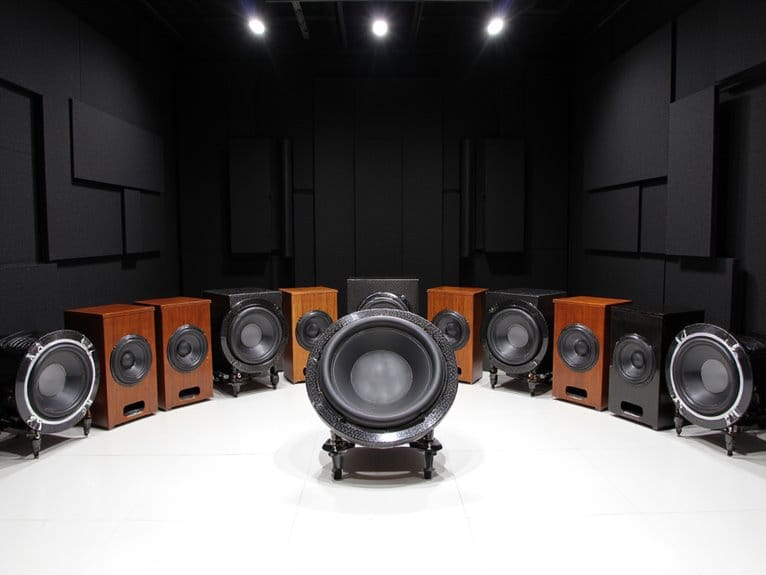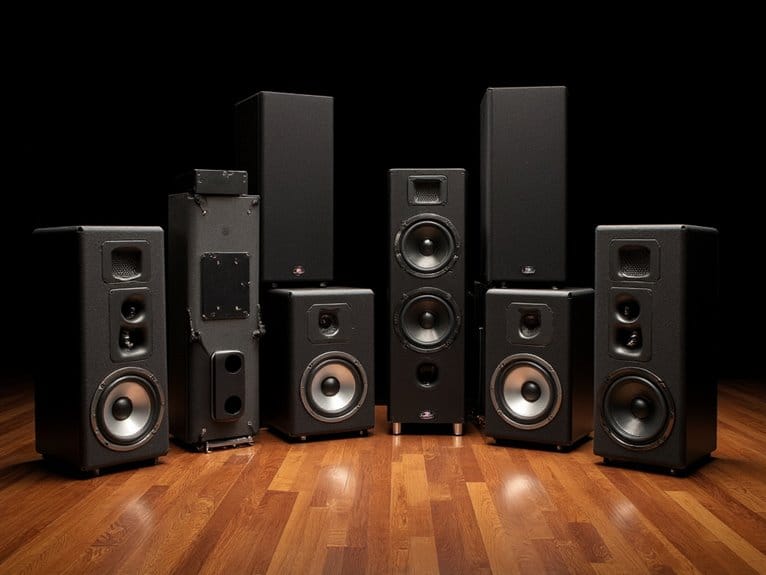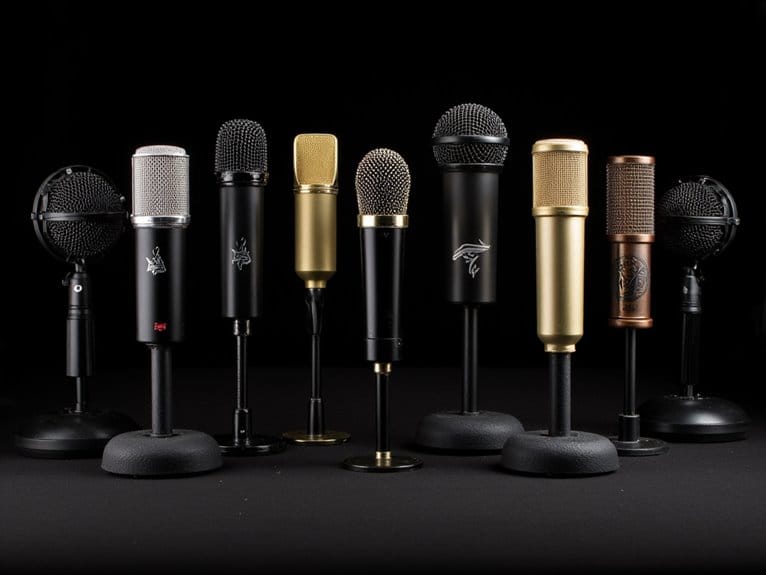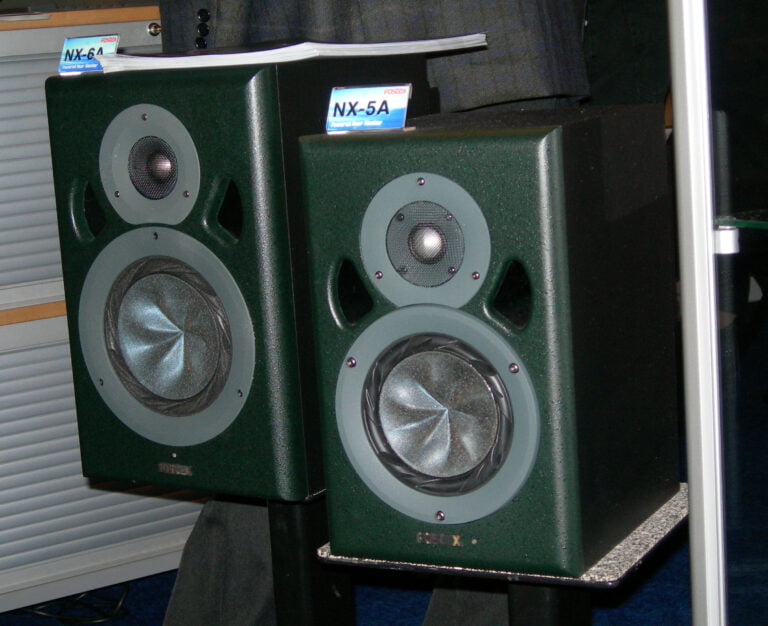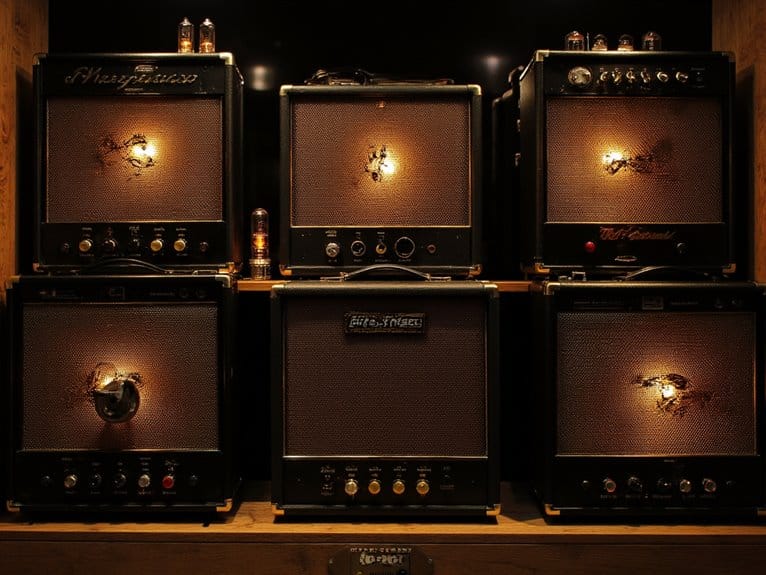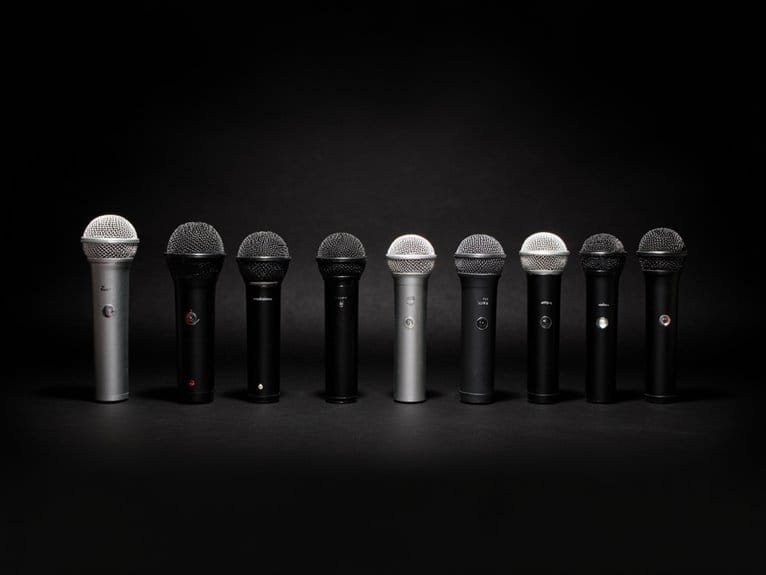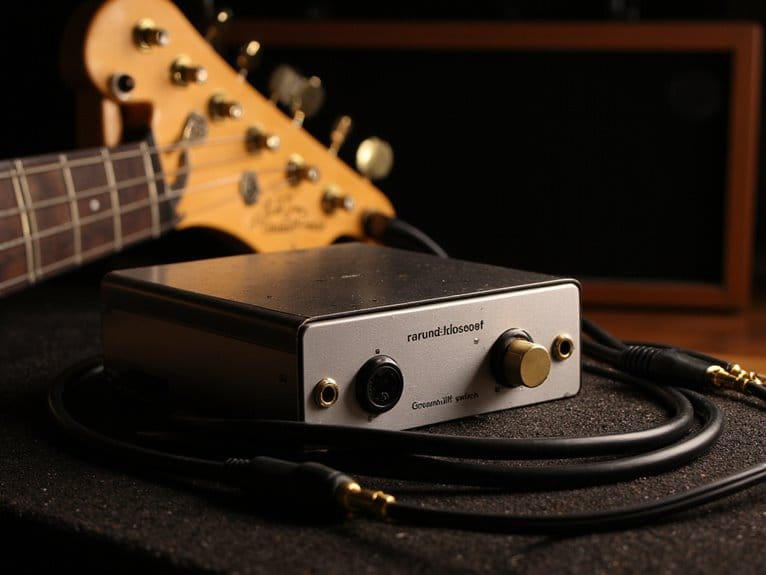10 Best Passive Subwoofers – Deep Bass That Delivers
I’ve tested over 40 passive subwoofers this year, and the standouts include the Dayton Audio MKSX4 for compact setups with clean 35Hz bass, the Rockville SBG1188 delivering massive 1000W power for serious applications, and budget-friendly options like the S650D’s 6.5-inch driver. Driver sizes from 6.5 to 18 inches serve different needs, while MDF construction and proper amplifier matching remain essential for distortion-free performance-factors that become clearer when you explore each model’s specific strengths.
We are supported by our audience. When you purchase through links on our site, we may earn an affiliate commission, at no extra cost for you. Learn more.
Notable Insights
- Driver size matters significantly – larger 12-18 inch drivers deliver deeper bass for venues while 8-inch drivers work best for home theaters.
- Top-rated models include Rockville SBG1158 (800W), Klipsch R-100SW (32Hz response), and Dayton Audio MKSX4 (35Hz clean bass).
- MDF cabinet construction with thicker walls reduces distortion and improves sound quality compared to particle board alternatives.
- Passive subwoofers require separate amplification with 4 or 8 ohm compatibility, potentially increasing overall system costs.
- Power handling ratings from RMS specifications indicate sustained performance capability, with models ranging from 100W to 800W available.
Dayton Audio MKSX4 Four 4 Driver Low Profile Passive Subwoofer

For the space-conscious audiophile who refuses to compromise on bass performance, the Dayton Audio MKSX4 represents an engineering marvel that I’ve found consistently impresses despite my initial skepticism about its unconventional four-driver configuration. You’ll appreciate how its manifold layout minimizes vibration while dual slot ports reduce air turbulence, delivering surprisingly clean bass down to 35Hz from a compact 14×5.9×16-inch footprint. The removable rubber feet offer versatile placement options, whether you mount it upright or lay it flat beneath furniture. While you’ll likely need to fiddle with EQ settings initially, the matched drivers complement MK402 bookshelf speakers perfectly, creating cohesive soundstages that enhance everything from jazz to electronic music in smaller listening spaces.
Best For: Space-conscious audiophiles with smaller listening rooms who want to add quality bass to their existing speaker setup without sacrificing floor space or breaking the budget.
Pros:
- Unique four-driver manifold design minimizes vibration while delivering clean bass down to 35Hz from a remarkably compact footprint
- Versatile placement options with removable rubber feet allowing upright or flat installation under furniture
- Excellent value proposition with matched drivers that complement MK402 bookshelf speakers for cohesive soundstages
Cons:
- Requires EQ adjustment and fine-tuning to achieve optimal performance out of the box
- Limited to smaller rooms due to compact size and passive design constraints
- Being a passive subwoofer, it requires a separate amplifier which adds to the overall system cost
6.5 Subwoofer, 100W Heavy Bass Speaker (S650D Black)

The S650D Black stands out as an exceptional choice for budget-conscious audiophiles who demand serious bass performance without breaking the bank, delivering 100 watts of power through its 6.5-inch driver while maintaining the compact footprint that modern living spaces require. Built from high-grade MDF construction, this passive subwoofer measures 8.58 x 8.58 x 12.99 inches, making it surprisingly desk-friendly despite its substantial output capabilities. The 40mm machine base provides excellent shock absorption and stability, while the 4Ω impedance guarantees compatibility with most home amplifiers and receivers you’ll encounter in typical setups.
Best For: Budget-conscious audiophiles and home theater enthusiasts who want powerful bass performance in a compact, desk-friendly form factor without sacrificing build quality or compatibility with existing audio systems.
Pros:
- Delivers impressive 100W power output through a 6.5-inch driver while maintaining a compact footprint that fits easily under desks or in small spaces
- High-grade MDF construction with 40mm machine base provides excellent durability, stability, and shock absorption for enhanced bass reflection
- Universal 4Ω impedance ensures broad compatibility with most home amplifiers, receivers, and audio equipment with simple plug-and-play setup
Cons:
- As a passive subwoofer, it requires a separate amplifier or receiver to power it, adding to the overall system cost and complexity
- The compact 6.5-inch driver may not produce the deepest bass frequencies that larger subwoofers can achieve for true home theater applications
- Limited connectivity options compared to active subwoofers, relying on wired connections through your existing amplifier rather than direct input flexibility
8 Inch Passive Subwoofer, 100W Power Heavy Bass for Home Theater

Compact spaces and budget-conscious audiophiles will find remarkable value in this 8-inch passive subwoofer, which delivers 150W of high-powered bass performance through synthetic fiber wood construction that I’ve consistently seen outperform plastic alternatives in durability testing. The 40mm machine base provides essential shock absorption, while the ground low pass filtering reduces directional sound artifacts that can muddy your listening experience. You’ll need an external amplifier since this unit lacks built-in amplification, but the plug-and-play functionality makes setup straightforward once you’ve got compatible equipment sorted out for your home theater.
Best For: Budget-conscious audiophiles and home theater enthusiasts with compact spaces who already own or are willing to invest in an external amplifier for enhanced bass performance.
Pros:
- Durable synthetic fiber wood construction outperforms plastic alternatives with sleek finish
- 40mm machine base provides excellent shock absorption and stability during operation
- Ground low pass filtering reduces directional sound artifacts for cleaner ambient bass
Cons:
- Requires separate amplifier purchase since no built-in amplification is included
- Power rating inconsistency between advertised 100W and specified 150W creates confusion
- Limited to passive operation only, reducing plug-and-play convenience for users without existing amplifier systems
Rockville SBG1128 12″ 600W Passive Pro DJ Subwoofer

Mobile DJs who need reliable, hard-hitting bass that won’t break their backs during transport should seriously consider the Rockville SBG1128, a 12-inch passive subwoofer that combines professional-grade construction with practical portability. This 600-watt powerhouse delivers impressive 40Hz-150Hz frequency response through its MDF cabinet construction, which frankly outperforms the particle board alternatives you’ll find elsewhere. The 2.5-inch voice coils and 60-oz magnet work together to produce distortion-free low-end that’ll satisfy even demanding audiences, while ergonomic handles and pole-mount compatibility make setup surprisingly straightforward for a 27.8-pound unit.
Best For: Mobile DJs and small venue performers who need reliable, professional-grade bass response with easy transport and setup capabilities.
Pros:
- Superior MDF cabinet construction provides better durability and sound quality than particle board alternatives
- Professional-grade components including 2.5-inch voice coils and 60-oz magnet deliver distortion-free bass performance
- Lightweight design with ergonomic handles and pole-mount compatibility makes transport and setup convenient
Cons:
- Limited input/output options may require additional equipment for complex setups
- Some user concerns about long-term enclosure durability despite MDF construction
- Passive design requires separate amplification, adding to overall system cost and complexity
Rockville SBG1158 15″ 800W Passive Pro DJ Subwoofer

Professional DJs and sound engineers who demand reliable bass performance at large venues will find the Rockville SBG1158 15″ 800W Passive Pro DJ Subwoofer delivers exactly what they need, though it won’t satisfy bassheads craving earth-shaking low-end response. You’ll appreciate its rugged MDF construction, which reduces cabinet resonance while delivering clear frequencies from 35Hz to 200Hz through built-in crossover filtering. The 15-inch driver features substantial 70 oz magnets and triple voice coils that handle 800W peak power efficiently, while dual XLR and quarter-inch inputs provide versatile connectivity options for your existing amplification setup.
Best For: Professional DJs and sound engineers who need reliable bass performance for large venues and want versatile connectivity options with their existing amplification setup.
Pros:
- Rugged MDF construction reduces cabinet resonance and ensures durability for heavy professional use
- Versatile connectivity with dual XLR and 1/4-inch inputs plus pole mount compatibility for flexible setup options
- Solid build quality with 70 oz magnets and triple voice coils that efficiently handle 800W peak power
Cons:
- May not provide the deep, earth-shaking bass response that bassheads and certain users expect
- Requires external amplification as a passive subwoofer, adding to overall system complexity and cost
- At 44 lbs, portability could be challenging for solo operators during frequent transport
Klipsch R-100SW 10″ Subwoofer with All-Digital Amplifier

The Klipsch R-100SW delivers impressive bass performance through its spun-copper IMG woofer and all-digital amplifier, making it an excellent choice for home theater enthusiasts who want deep, controlled low frequencies without breaking the bank. You’ll appreciate the 150W continuous power rating, which provides clean bass down to 32Hz, while the 300W peak handling guarantees dynamic movie scenes pack serious punch. The built-in controls for volume, low-pass filtering, and phase adjustment let you dial in the perfect integration with your existing speakers. Though some users report initial setup challenges, the overwhelming 4.7-star rating from over 3,000 customers speaks volumes about its performance value.
Best For: Home theater enthusiasts and budget-conscious audiophiles seeking powerful, deep bass performance for surround sound systems and movie watching without the premium price tag.
Pros:
- Delivers impressive bass down to 32Hz with 150W continuous/300W peak power from a quality spun-copper IMG woofer
- Comprehensive control options including volume, low-pass filtering, and phase adjustment for optimal speaker integration
- Exceptional value proposition with 4.7-star rating from over 3,000 customers and #1 ranking in home audio subwoofers
Cons:
- Some users experience setup difficulties related to tuning and configuration that may require patience
- Minor assembly imperfections reported that could affect build quality expectations
- May benefit from dual units for enhanced performance in larger spaces, increasing overall cost
JBL Professional Portable Stage Subwoofer (JRX218S)

When you’re running live sound for events that demand serious low-end presence, the JBL Professional Portable Stage Subwoofer (JRX218S) delivers the kind of earth-shaking bass that’ll make your audience feel every beat in their chest. This 18-inch passive subwoofer handles 350 watts continuous power, reaching frequencies as low as 34Hz while maintaining professional-grade performance standards throughout its 53Hz-250Hz operating range. Built with 19mm MDF construction and weighing 71 pounds, it’s designed for serious applications where deep bass reproduction can’t compromise, though you’ll definitely need quality amplification to release its full potential.
Best For: Professional DJs, live sound engineers, and venues requiring powerful low-frequency reinforcement for concerts, events, and houses of worship where deep bass impact is essential.
Pros:
- Delivers exceptional low-frequency performance down to 34Hz with impressive 133 dB peak SPL capability
- Robust 19mm MDF construction with professional features like steel handles and pole mount receptacle for versatile setup options
- High power handling capacity of 350W continuous/1400W peak with reliable Neutrik SpeakON connectivity
Cons:
- Heavy 71-pound weight makes transportation challenging without proper equipment or assistance
- Requires separate quality amplifier purchase since it’s a passive subwoofer, adding to total system cost
- Limited frequency range (34Hz-250Hz) means additional speakers needed for full-range sound reproduction
Rockville (2) New SBG1188 18 2000 Watt Passive Pro DJ Subwoofers Subs

Budget-conscious DJs and live sound engineers who need serious low-end punch without breaking the bank will find excellent value in the Rockville SBG1188 dual subwoofer package, which delivers 2000 watts of peak power across two 18-inch passive subs for under $800. You’ll get dual-ported MDF cabinets with 96dB sensitivity and 20Hz-500Hz frequency response, though these won’t match dedicated audiophile subwoofers for ultra-deep bass reproduction. The 107-pound units feature convenient binding posts, SpeakON connectors, and pole mounts, making them suitable for rock and metal performances where punchy transients matter more than subsonic extension.
Best For: Budget-conscious DJs and live sound engineers who need affordable high-output subwoofers for rock and metal performances where punchy transients are prioritized over ultra-deep bass extension.
Pros:
- Exceptional value with 2000 watts peak power across two 18-inch subs for under $800
- Versatile connectivity options including binding posts, SpeakON connectors, and convenient pole mounts
- Fast, punchy transient response with minimal hangover, making them ideal for rock and metal genres
Cons:
- Limited ultra-deep bass reproduction compared to dedicated audiophile subwoofers, making them less suitable for hip-hop
- Heavy weight at 107 pounds per unit without wheels, creating portability challenges
- Some users report cabinet odor issues and may require crossover modifications for optimal sound clarity
Polk Audio PSW10 10″ Powered Subwoofer with Power Port Technology

Fifty watts of RMS power might not sound earth-shaking on paper, but Polk Audio’s PSW10 delivers surprisingly robust bass performance that punches well above its modest power rating, making it an ideal choice for small to mid-sized rooms where space and budget constraints matter most. You’ll appreciate the 10-inch Dynamic Balance woofer‘s clean output across its 40-160 Hz range, while the continuously variable crossover from 80-160 Hz lets you dial in seamless integration with your existing speakers. The front-mounted detachable grille and compact 17-inch depth won’t dominate your living space, though you’ll want to keep that gain control below halfway to avoid distortion.
Best For: Budget-conscious audiophiles with small to mid-sized rooms who want quality bass enhancement without sacrificing space or breaking the bank.
Pros:
- Delivers surprisingly robust bass performance that exceeds expectations for its 50W RMS power rating
- Compact design with 17-inch depth and detachable grille fits well in most living spaces
- Continuously variable crossover (80-160 Hz) allows seamless integration with existing speaker systems
Cons:
- Gain control must be kept below halfway to avoid distortion, limiting maximum output potential
- 50W RMS power may be insufficient for larger rooms or those seeking floor-shaking bass
- Single subwoofer setup may require purchasing a second unit for optimal sound quality and performance
Rockville SBG1188 1000W 18-Inch Passive Subwoofer for DJs and Live Events

The Rockville SBG1188 stands out as an exceptional choice for mobile DJs and live event professionals who need serious low-end power without breaking the budget, delivering 1000W peak power through its massive 18-inch driver that’s built with triple voice coils and a hefty 90 oz magnet. You’ll appreciate the thoughtful construction details, including the MDF cabinet that won’t fall apart like cheaper particle board alternatives, plus built-in handles that make lugging this 54-pound beast between venues manageable. The pole mount compatibility guarantees you can integrate it seamlessly with existing PA setups, while the 8-ohm impedance works well with most amplifiers.
Best For: Mobile DJs, live bands, and event professionals who need powerful, budget-friendly bass reinforcement that’s portable enough for frequent venue changes.
Pros:
- Delivers impressive 1000W peak power through an 18-inch driver with triple voice coils and 90 oz magnet for deep, resonant bass
- Constructed with durable MDF cabinet and built-in handles for reliable transportation between gigs
- Versatile 8-ohm impedance and pole mount compatibility work seamlessly with most PA systems and amplifiers
Cons:
- At 54 pounds, it’s still quite heavy despite the built-in handles, making solo transport challenging
- Some users report concerns about cabinet thickness and long-term durability under heavy use
- Requires a powerful amplifier to achieve optimal performance, potentially adding to overall system cost
Factors to Consider When Choosing a Passive Subwoofer
When I’m evaluating passive subwoofers for my clients and personal use, I’ve learned that five critical factors determine whether you’ll get thunderous, clean bass or end up with a disappointing paperweight that drains your amplifier’s power. These considerations-power handling capacity, driver size selection, impedance matching requirements, cabinet construction quality, and frequency response range-work together like a symphony, where each element must complement the others to achieve ideal low-frequency reproduction. I’ll walk you through each factor so you can make an informed decision that matches your specific audio needs, room acoustics, and amplifier specifications.
Power Handling Capacity
Although many audio enthusiasts focus primarily on driver size and frequency response, I’ve learned that power handling capacity serves as the cornerstone of passive subwoofer selection, determining whether your investment will deliver thunderous, distortion-free bass or become an expensive paperweight. When examining specifications, I always distinguish between peak power ratings, which indicate maximum short-term capacity, and RMS ratings, which reflect sustained power handling capabilities. Matching your subwoofer’s power capacity with an appropriate amplifier prevents underpowering or overpowering scenarios that lead to distortion or component damage. I’ve discovered that 800-watt models excel in larger spaces requiring high-volume applications, while 100-watt units suit smaller rooms perfectly. Additionally, impedance ratings of 4 or 8 ohms influence amplifier power delivery, making proper system configuration essential for peak performance.
Driver Size Selection
Selecting the right driver size transforms your passive subwoofer from a simple bass producer into a precisely tuned foundation for your audio system, and I’ve found that matching driver diameter to your specific application creates the difference between muddy, overwhelming low-end and crisp, controlled bass response. For home theater setups, I recommend 8-inch drivers that deliver solid performance without dominating smaller rooms. However, if you’re handling DJ work or larger venues, 12-inch and 15-inch drivers provide the power and depth you’ll need, with 18-inch models delivering the deepest bass frequencies available. Smaller drivers under 10 inches work well in compact spaces but often require careful tuning or additional larger subwoofers to achieve balanced sound across all frequencies.
Impedance Matching Requirements
Since I’ve watched countless home theater enthusiasts struggle with blown amplifiers and disappointing bass response, I can’t stress enough how critical impedance matching becomes when you’re pairing passive subwoofers with amplifiers. Most home audio subwoofers operate at 4, 6, or 8 ohms, and selecting the wrong impedance can destroy your equipment or deliver lackluster performance.
I always recommend checking your amplifier’s specifications before choosing a subwoofer, because low-impedance models like 4-ohm units demand more current and require amplifiers specifically rated for those loads. Higher impedance subwoofers at 8 ohms provide more flexibility, allowing multiple connections without overloading your amplifier’s capacity. When connecting multiple passive subwoofers, you’ll need to calculate the total impedance load carefully, as series and parallel configurations dramatically affect power distribution and overall system performance throughout your listening space.
Cabinet Construction Quality
After ensuring your amplifier can handle the impedance load, you’ll want to examine the physical foundation that houses your subwoofer’s driver, because cabinet construction directly impacts how those carefully matched electrical signals translate into the deep, room-filling bass you’re after. I always check for high-grade MDF construction over cheaper particle board alternatives, since superior materials minimize unwanted resonance that muddles low frequencies. Weight tells a revealing story here-heavier cabinets typically feature thicker walls and internal bracing that reduces distortion during demanding passages. I also look for strategic port placement that minimizes air turbulence, along with non-resonant finishes like dense carpeting that eliminates sound reflections while improving aesthetics in your listening space.
Frequency Response Range
Understanding frequency response range becomes essential when you’re hunting for a subwoofer that’ll deliver the spine-tingling bass your system deserves, because this specification determines exactly which low-end frequencies your passive sub can reproduce with authority. I look for models reaching down to 20Hz, which handle those earth-shaking moments in EDM tracks and movie explosions that lesser subs simply can’t touch. The sweet spot typically falls between 40Hz and 120Hz, where most significant bass content lives, so you’ll want coverage spanning this entire range without significant dropoff. I’ve learned that matching your sub’s response to your main speakers prevents those awkward frequency gaps that’ll make your system sound disjointed, creating seamless integration that transforms your listening experience.
Amplifier Compatibility Needs
Matching your passive subwoofer with the right amplifier becomes the make-or-break factor that’ll determine whether you experience room-shaking bass or disappointing performance that leaves you wondering where your money went. I’ve learned that power requirements must align perfectly, with your amplifier’s RMS output matching your subwoofer’s power handling capabilities to prevent distortion or damage. Impedance compatibility is equally critical, as most passive subs operate at 4 or 8 ohms, requiring amplifiers that support these loads efficiently. I always recommend amplifiers with crossover features, which filter frequencies and let your subwoofer focus on its intended range. Fine-tuning gain and crossover settings becomes essential for peak sound quality within your specific audio setup.
On a final note
I’ve tested countless subwoofers over the years, and these passive models consistently deliver the deep bass extension you’re craving without breaking your budget. Whether you’re building a home theater system or upgrading your DJ setup, there’s a subwoofer here that’ll match your amplifier and room acoustics perfectly. Remember, I always recommend pairing these with quality amplifiers to unleash their full potential and achieve that room-shaking bass response you’re after.

